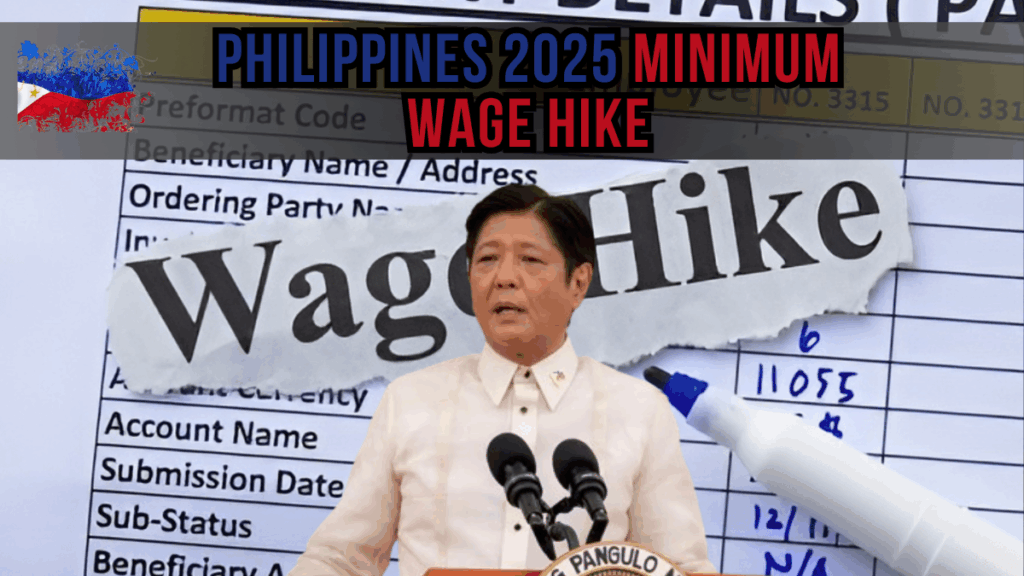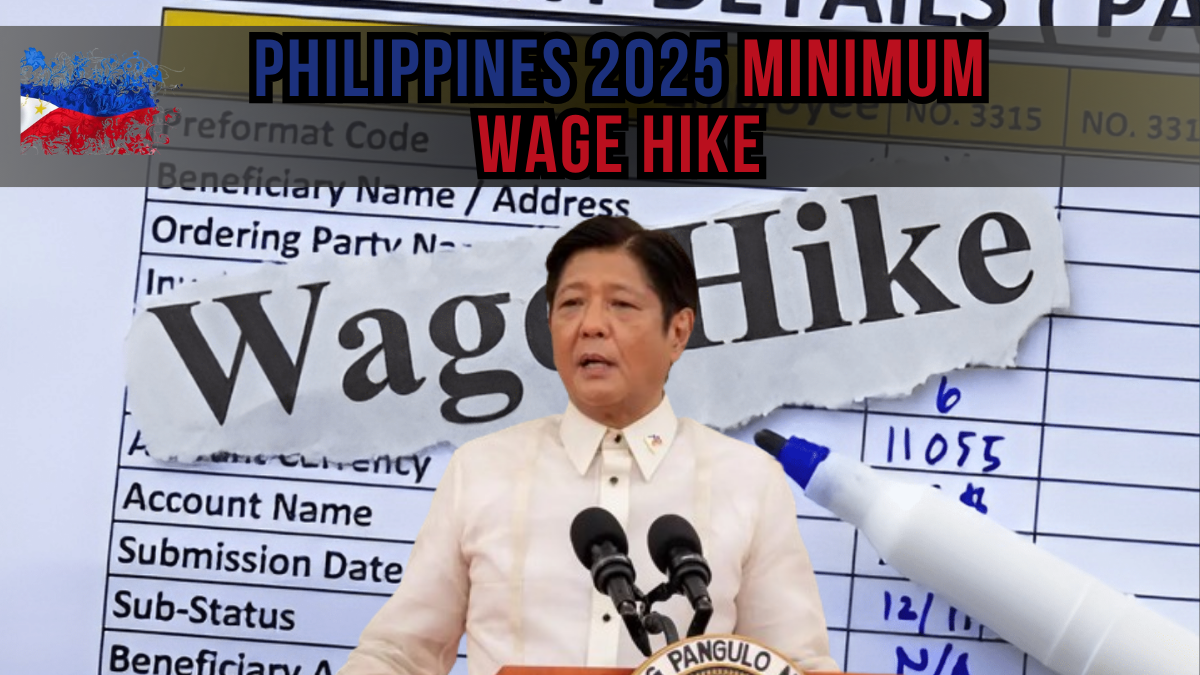In August 2025, the Department of Labor and Employment (DOLE) will implement a minimum wage increase for Metro Manila workers. This decision follows extensive consultations with labor unions, employer groups, and policymakers.

The increase aims to offset rising living costs and improve the welfare of workers in the National Capital Region (NCR), especially in industries where wages have not kept pace with inflation.
Quick Summary: 2025 Minimum Wage Increase in Metro Manila
Key Detail |
Information |
|---|---|
Effective Date |
August 2025 |
Region Covered |
National Capital Region (NCR / Metro Manila) |
Previous Rates |
₱573–₱610 daily (sector-based) |
New Rates |
₱620–₱660 daily (sector-based) |
Daily Increase |
₱47–₱50 |
Monthly Impact |
₱1,000–₱1,300 additional take-home pay |
Covered Workers |
Private sector, non-agriculture, service, manufacturing, construction |
Exemptions |
Micro-enterprises with ≤10 workers (subject to DOLE approval) |
Official Source |
Why the Wage Hike Is Timely
Inflation in recent years has sharply increased the cost of essentials such as:
- Food and groceries
- Transportation fares
- Housing and utilities
- Education costs for children
For many households surviving on a single income, even a small increase in daily wages can provide much-needed relief.
This wage order is not just an economic policy—it’s also a social intervention to help bridge the gap between stagnant wages and the rising cost of living.
New Daily Wage Rates Effective August 2025
The increase varies slightly by sector to reflect differences in business capacity and operational costs.
Industry Sector |
Previous Daily Wage |
New Daily Wage |
Increase |
|---|---|---|---|
Non-Agricultural Sector |
₱610 |
₱660 |
₱50 |
Retail/Service (≤10 workers) |
₱573 |
₱620 |
₱47 |
Manufacturing Sector |
₱580 |
₱630 |
₱50 |
This translates to an additional ₱1,000–₱1,300 per month for full-time workers, which can cover part of rent, groceries, or transportation expenses.
Who Is Covered by the 2025 Wage Increase?
The adjustment applies to:
- Non-agricultural workers in NCR
- Retail and service industry employees, including hospitality and cleaning staff
- Manufacturing and industrial workers
- Construction and maintenance employees
- Employees in micro-enterprises (≤10 workers) — though these businesses may apply for exemptions if they can prove financial hardship
Impact on Workers
For employees, this increase represents:
- Better household budgeting capacity
- The ability to save for emergencies or educational expenses
- Improved morale and a stronger sense of being valued in the workplace
- Potentially lower employee turnover as workers feel more financially secure
Workers like Marissa, a cashier from Quezon City, say:
“Even an extra ₱50 a day helps. I can save more for my kids’ school needs. It feels like our voices are being heard.”
Employer Response and Support Measures
Large corporations may find it easier to absorb the wage increase, but small and medium enterprises (SMEs) could feel more financial pressure.
To assist, DOLE has:
- Allowed micro-enterprises to apply for temporary exemptions
- Encouraged government financial aid programs to help small businesses adjust payroll
- Urged companies to plan and budget ahead for the increased labor costs
Employers are advised to:
- Review payroll systems to incorporate the new rates.
- Reassess pricing strategies to maintain profitability.
- Explore government assistance for SMEs.
Economic Implications of the Wage Hike
Positive Impacts
- Boost in domestic spending: Workers with higher disposable income may spend more, benefiting local businesses.
- Improved worker productivity: Better wages can lead to higher morale and efficiency.
- Reduced turnover rates: Fair pay can encourage employee loyalty.
Potential Challenges
- Inflationary risks: Higher wages could push prices up if businesses pass on costs to consumers.
- Pressure on micro-enterprises: Smaller businesses might struggle with compliance, potentially affecting hiring rates.
Economic analysts believe that careful monitoring will be needed to balance wage growth with overall economic stability.
DOLE’s Next Steps
The 2025 NCR wage increase is part of a larger national review. DOLE has confirmed that:
- Other regions may also see wage adjustments later in the year.
- The government will continue monitoring inflation trends and employer capacity.
- Long-term policy will focus on regional equity and sustainable wage growth.
Frequently Asked Questions (FAQs)
Q1. When will the new wage rates take effect?
Ans. The increase will be effective from August 2025.
Q2. Which workers are covered?
Ans. All private sector workers in NCR, including non-agricultural, service, manufacturing, and construction employees.
Q3. Can small businesses avoid paying the new rate?
Ans. Micro-enterprises with 10 or fewer workers may apply for exemptions if they meet DOLE’s hardship criteria.
Q4. How much more will workers earn each month?
Ans. Between ₱1,000 and ₱1,300 extra per month, depending on sector and working days.
Q5. Where can I find the official wage order?
Ans. Visit DOLE’s official site: https://www.dole.gov.ph
Conclusion: A Step Toward Fairer Wages
The 2025 minimum wage hike in Metro Manila is a significant step toward improving the livelihoods of Filipino workers. While it presents challenges for some employers—particularly micro and small enterprises—the broader goal is to ensure that wages keep pace with the cost of living.
For workers, the change offers financial relief and improved morale. For the economy, it has the potential to stimulate domestic spending and promote inclusive growth.
The key now lies in effective implementation, monitoring, and support to ensure that both workers and employers benefit in the long run.
Click HERE for Information
